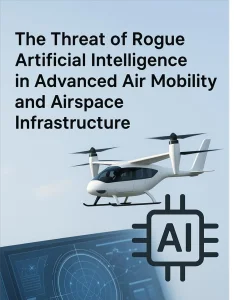- Directory
- Advanced Air Mobility White Papers
- Advanced Air Mobility (AAM)
- The Threat of Rogue Artificial Intelligence in Advanced Air Mobility
The Threat of Rogue Artificial Intelligence in Advanced Air Mobility
White Paper Details
This white paper examines the critical security threats posed by rogue AI in Advanced Air Mobility systems, including eVTOLs and autonomous drones. It analyzes potential attack vectors, consequences of AI exploitation, regulatory gaps, and provides comprehensive mitigation strategies for protecting future airspace infrastructure from malicious or unpredictable AI behavior.
<!-- notionvc: 05ad4d69-b237-444e-892b-38cc056aa582 -->
This white paper addresses the emerging threat of rogue artificial intelligence in Advanced Air Mobility (AAM) and airspace infrastructure systems. As AAM technologies, including electric vertical takeoff and landing (eVTOL) aircraft and autonomous drones, increasingly rely on AI for flight operations, traffic management, and decision-making, new vulnerabilities emerge that could be exploited by malicious actors or result from unpredictable AI behavior.
The document identifies multiple attack surfaces within AAM systems, including onboard flight control systems, ground-based infrastructure, communication networks, and air traffic management platforms. These vulnerabilities could lead to severe consequences such as unauthorized vehicle control, airspace gridlock, privacy breaches, and potential weaponization of AAM platforms.
Key findings highlight how AI integration in Unmanned Traffic Management (UTM) and NextGen Air Traffic Management systems creates unprecedented risks.
=The paper examines historical precedents, including the Boeing 737 MAX MCAS malfunction and DJI drone geofencing hacks, demonstrating how AI-related failures can have catastrophic outcomes.
The white paper identifies significant regulatory and policy gaps in current frameworks, noting that existing aviation regulations were not designed to address AI-specific threats. It emphasizes the need for AI-specific certification standards, adversarial testing protocols, and international cooperation.
Proposed mitigation strategies include implementing redundant AI systems, establishing secure communication protocols, developing AI explainability standards, and creating specialized response teams for AI-related incidents. The document recommends a multi-layered defense approach combining technical safeguards, regulatory frameworks, and operational procedures.
The paper concludes by emphasizing the critical importance of proactive measures to secure AAM infrastructure against rogue AI threats, warning that failure to address these vulnerabilities could result in loss of life, economic damage, and erosion of public trust in autonomous aviation technologies.
